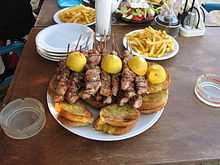Greek restaurant
A Greek restaurant is a restaurant that specializes in Greek cuisine.[1] Several types of Greek restaurants exist. Going out to eat is "part of the local culinary culture" in modern Greece.[2] Greek restaurants in the United States tend to be moderately priced, and they vary in terms of types of service, cuisine and menu offerings, table settings and seating arrangements.[1] Greek restaurants may also offer dishes from other various cuisines on their menus.
By type
Estiatório
The estiatório (plural estiatória) is a type of modest restaurant in Greece.[3] They have been described as "something of a vanishing breed".[4] An estiatório may purvey dishes such as casseroles, meat and game stews, baked meat and fish, macaroni pie and mayirefta in the form of moussaka.[4]
Gyradiky
Giradiky restaurants purvey the popular Greek dish gyros.[2] In Greece, gyros are typically prepared using spiced ground pork shoulder meat, while in the United States they are commonly prepared with ground lamb sliced from a vertical rotisserie spit.[2]

Mezedopoleio
Meze restaurants are known as mezedopoleío (singular)[2] or mezedopoleía (plural), and serve appetizers known as meze or orektiko (plural mezedes/orektika) to complement beverages. Some meze restaurants simply serve whatever has been prepared that day, not offering menus.[2]
Ouzeri
Establishments known as ouzerí are a type of café that serves drinks such as ouzo or tsipouro, are similar to mezedopoleio and souvlatzidiko restaurants, and also provide similar foods and service. A tsipourádiko is a "local variant of an ouzerí".[5]
Souvlatzidiko
Souvlatzidiko restaurants purvey the well-known Greek dish souvlaki.[2] Souvlaki is prepared using cubed pork leg meat that is cooked as a kebab.[2]
Taverna
Tavernas are typically medium-sized restaurants with affordable pricing[2] that purvey a variety of Greek dishes, foods and beverages. Tavernas originated in Greece.
- Greek restaurants by type
-
.jpg)
A gyro restaurant (gyradiko) in Latin Quarter, Paris
-
A gyradika in Cyprus (left corner)
By country
Greece

 |
| Greek cuisine |
|---|
| History |
| Regions |
| Influences |
|
| Greece portal |
In many Greek restaurants in Greece, it is not considered impolite for guests to enter the kitchen to see what is cooking before ordering, although this may not occur in fine dining and hotel restaurants.[3] After this, a waiter may be notified of guest choices.[3] Table service is often relaxed and laid-back, and patrons may need to flag down wait staff to order and request items.[3] Wine is commonly consumed during lunch and dinner.[3] Ouzo is typically available in Greek restaurants.
United States
There are many Greek restaurants in the United States, with 3,100 categorizing themselves as such, and at least one exists in every U.S. state.[6] In the U.S., Greek restaurateurs may provide authentic Greek cuisine and customs.[6] They may also offer dishes from other cuisines. Many Greek restaurants in the U.S. were started by immigrants from Greece,[1] some of which began due to new health codes in the U.S. during the early 20th century that limited or restricted food carts.[6] Per these restrictions during this time, some people opened Greek restaurants instead.[6] Additionally during this time period, many Greek confectionery and sweetshop businesses declined due to an increase in manufactured candies and sweets.[6] Many of these companies transformed their businesses into lunch rooms, and later, restaurants.[6] It has been estimated that approximately 7,000 Greek restaurants existed in the U.S. by the beginning of the Great Depression.[6]

It has been suggested that the first documented Greek restaurant in the U.S. was the Peloponnesos in Manhattan, New York City, in the Lower East Side, which may have opened "as early as 1857", although it has been stated that its opening date was "more likely in the 1880s.[6]
During the early 1900s, some Greek immigrant restaurateurs expanded their operations into chain restaurants.[6] Greek restaurant chains during this time period included (by location):[6]
- Chicago – John Raklios owned 32 Greek restaurants in Chicago
- New York – Foltis, Stavrakas, Litzotakis
- North Carolina, South Carolina and Virginia: Lambropoulos
In 1913, there were "several hundred Greek-owned lunchrooms and restaurants in Chicago".[7]
In the 1930s, many Greek restaurants in the U.S. went out of business, in part due to problems that occurred during the Great Depression.[6] During this time, competition increased due to an increase of affordably-priced lunch counters opening in various types of stores, such as drug stores and department stores.[6] Additionally, more patrons could not afford to eat out in restaurants during this time.[6]
During the 1950s and 1960s, the number of Greek restaurants increased, and by the 1970s they were a significant pillar in the U.S. restaurant landscape.[6]
Of note is that Greek immigrants in the U.S. also opened other types of restaurants, such as restaurants serving other cuisines, diners, luncheonettes, pizzerias and coffeehouses.[1] Some immigrant-owned Greek restaurateurs opened restaurants that specialized in other ethnic or national cuisines, such as Italian cuisine.[1]
Cuisine
Appetizers and light meals
A tavérna or estiatório may offer a meze as an orektikó. Many restaurants offer their house pikilía, a platter with a variety of various mezedes that can be served immediately to customers looking for a quick or light meal. Krasomezédhes (literally "wine-meze") are mezedes that go well with wine; ouzomezédhes are mezedes that go with ouzo. Psomi oretiko is a bread appetizer that is common in Greek restaurants.[8]
Main courses
In Greece, main courses may be ordered directly from the kitchen, from a menu board[3] or from menus. In coastal Greek restaurants, fish dishes may be weighed and sold by the kilogram, which occurs prior to cooking.[3] Frozen fish is sometimes used, which may be described on menus as katepsigmenos.[3] Seafood dishes that are staples include swordfish, octopus, squid, sardines and prawns.[3]
- Greek restaurant cuisine
-
.jpg)
Grilled vegetables at a Greek and Santorinian restaurant
-
.jpg)
Fried squid at a Greek restaurant
-
.jpg)
Salted cod with garlic sauce, a traditional Greek dish for the day of the Annunciation,[1] served at a Greek restaurant
- ^ Cite error: The named reference
Traditional_Festivalswas invoked but never defined (see the help page).
Gallery
-

Depiction of a Greek road sign signifying dining in an area
-
.jpg)
A small restaurant in Delphi, Greece
-
.jpg)
Interior of a taverna in Kos, Greece
-
A fast casual Greek restaurant
-

A Greek restaurant (in the background) in Rhodes, Greece
See also
Notes
- ↑ 1.0 1.1 1.2 1.3 1.4 Halper 2001, p. 9A-670.
- ↑ 2.0 2.1 2.2 2.3 2.4 2.5 2.6 2.7 Albala 2011, p. 168.
- ↑ 3.0 3.1 3.2 3.3 3.4 3.5 3.6 3.7 3.8 Michelin Travel & Lifestyle 2012.
- ↑ 4.0 4.1 Garvey & Fisher 2009, p. 67.
- ↑ Dubin 2011, p. 293.
- ↑ 6.0 6.1 6.2 6.3 6.4 6.5 6.6 6.7 6.8 6.9 6.10 6.11 6.12 6.13 Moskos & Moskos 2013, pp. 154–158.
- ↑ Moskos & Moskos 2013, p. 31.
- ↑ Sarianides 2004, p. 28.
- ↑ Traditional Festivals (M-Z), p. 12.
References
- Albala, K. (2011). Food Cultures of the World Encyclopedia. Food Cultures of the World Encyclopedia (v. 1). Greenwood. ISBN 978-0-313-37626-9.
- Dubin, M. (2011). DK Eyewitness Travel Guide: Greece Athens & the Mainland: Greece Athens & the Mainland. Eyewitness Travel Guides. DK Publishing. ISBN 978-0-7566-8434-1.
- Garvey, G.; Fisher, J. (2009). The Rough Guide to Greek Islands. Rough Guide to... Rough Guides. ISBN 978-1-4053-8412-4.
- Halper, E.B. (2001). Shopping Center and Store Leases. Real estate series (v. 2). Law Journal Seminars-Press. ISBN 978-1-58852-003-6.
- Michelin (2012). Michelin Green Guide Greece. Green Guide/Michelin. Michelin Travel & Lifestyle. ISBN 978-2-06-718214-1.
- Moskos, P.C.; Moskos, C.C.; Dukakis, M. (2013). Greek Americans: Struggle and Success. Transaction Publishers. ISBN 978-1-4128-5310-1.
- Sarianides, G. (2004). Nosthimia!: The Greek American Family Cookbook. New American Family Cookbooks. Capital Books. ISBN 978-1-931868-73-0.
- Traditional Festivals, Vol. 2 [M – Z]. ISBN 978-1-57607-089-5.
Further reading
| Wikimedia Commons has media related to Greek style restaurants. |
- Moskos & Moskos 2013, p. 39.
- Moskos & Moskos 2013, p. 72.
- Moskos & Moskos 2013, p. 172.
- Thorn, Bret (May 27, 2013). "Greek chains 'Americanize' dishes". Nation's Restaurant News. Retrieved April 7, 2015. (subscription required)
- Kruse, Nancy (January 14, 2013). "Greek food gains ground in U.S.". Nation's Restaurant News. Retrieved April 7, 2015. (subscription required)
- Maze, Jonathan (October 8, 2007). "On Food: At restaurants Greek and otherwise, chefs find a bit of feta makes their dishes better". Nation's Restaurant News. Retrieved April 7, 2015. (subscription required)
- Stone, T. (2003). The Summer of My Greek Taverna: A Memoir. Simon & Schuster. ISBN 978-0-7432-4771-9.



